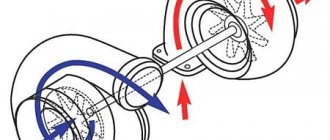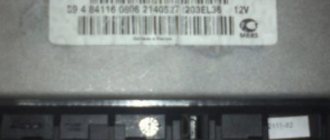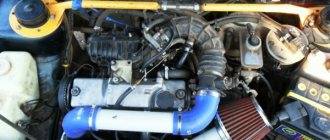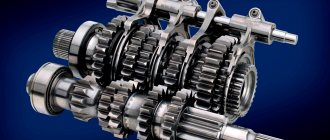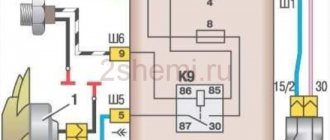The number of cars produced with turbocharged engines is constantly growing, as such cars are in demand in the market. However, not all car owners know how a turbine on a gasoline engine works, although they show interest in this topic. The point here is not laziness at all, but an overly complex presentation of the material, making it inaccessible to understanding for most motorists.
First you need to understand what a turbine is for : it allows you to increase the power of a small engine without harming it and without increasing fuel consumption. But there are certain operating features, the observance of which will make it possible to increase efficiency and extend the total operating time of the power unit.
At what speed does the turbine “turn on” (turbo boost)
Many drivers are convinced that the turbine turns on only at high speeds, since at low speeds they do not feel the effect of turbocharging on movement. This is a half-truth - in fact, the turbine on the car works constantly, but at low speeds the discharge is weak. Let's take a closer look at it:
- When the engine operates at up to 1500-2000 rpm, the exhaust gases create only a slight pressure on the turbine blades. Therefore, a small amount of oxygen is pumped into the internal combustion chamber, so the driver does not feel an increase in power. This phenomenon is called turbo lag.
- As power increases above 2000 rpm, exhaust gases begin to affect the turbines, which leads to a noticeable injection of oxygen into the internal combustion engine. The relationship here is directly proportional - the higher the speed, the stronger the turbocharging will work and vice versa. This phenomenon is called turbo boost.
Note! Many turbines are equipped with a safety valve that blocks operation of the device at very high speeds (red zone of the tachometer). This is done so as not to damage the engine.
Turbine operation
The design of the turbocharger makes it dependent on the quality of the oil, so there is no point in trying to save money on it. Untimely oil changes can cause problems in the operation of the mechanism.
After purchase, a car equipped with a turbine requires an oil change and thorough cleaning of the fuel system; however, different oils cannot be mixed.
After a long trip, it is not recommended to immediately turn off the engine , allowing it to run a little and cool down. An abrupt shutdown may indicate a decrease in the strength of structural elements caused by temperature changes.
Why the turbine may not turn on - malfunctions
When driving a car with a turbocharging system, the driver may encounter many problems and malfunctions. Let's look at the main problems and methods for solving them:
- Safety valve malfunction . It happens that the valve becomes clogged with debris or cracks, which leads to blocking the operation of the turbine. It is quite simple to establish a breakdown - up to approximately 3-4 thousand revolutions, the valve can still work, so it will pump air. However, if this indicator is exceeded, it abruptly closes the turbine, which leads to a drop in power. To solve the problem, turn off the car's electronic systems, open the hood, disconnect the negative terminal from the battery, find the turbine, turn off the lubrication system and remove the device (usually it is located next to the engine). Then remove the valve and inspect it, if necessary, clean the device or replace it.
- Leaky fastening of turbocharging components . To ensure maximum air injection power into the internal combustion engine, it is necessary that the turbine parts are hermetically attached to the vehicle. In the case of a leaky fastening, the pumping power drops sharply. The presence of a problem can be determined by two signs - a sharp decrease in power and the appearance of a characteristic whistle while the car is running. To deal with the problem, you need to turn off the power to the car, open the hood and check the tightness of the device. Problems may arise with the fitting, oil supply pipe, valve, and so on. To fix the problem, you need to restore the tightness (for example, if the problem is in the fitting, you need to buy a new one).
- Using bad oil . For the turbocharging system to operate effectively, the device must be lubricated with oil. However, it happens that the driver uses cheap, low-quality oil with a lot of impurities for lubrication - in this case, the efficiency of turbocharging will significantly decrease. It is very easy to identify the problem - while the car is moving, a sharp loud grinding noise appears in the car, and the engine power does not increase when accelerating to high speeds. The solution to the problem is to buy new high-quality oil and pour it into the car instead of the old one.
What is turbojam or turbolag?
The principle of operation of turbocharging is that the engine “accelerates” itself due to its own work. This feature causes a problem such as turbo lag or turbo lag. It manifests itself in the form of a drop in power that appears after sharply pressing the gas pedal.
At the dawn of turbocharged engines, things got ridiculous - by pressing the gas pedal too sharply and too hard, you could completely turn off the engine. Nowadays, complex mechanical and electronic components will prevent this from happening, but the effect of turbo lag with an unpleasant loss of power still remains. This especially affects cheap turbo systems or those that are incorrectly installed and configured.
To smooth out turbo lag, they use clever electronic systems for proactively increasing speed. They register sharp presses on the accelerator pedal and spin the compressor using electric drives, without waiting for the turbine to “wake up”. The price of such solutions is usually quite high, so they are found mainly only on sports cars.
Myths about turbocharging in the engine
There are many myths among drivers about the operation of the turbocharging system. Let's look at the main stereotypes and find out why they are false:
| Myth 1 – the turbocharging system can be removed at any time without negative consequences | The design and volumes of the internal combustion engine chamber are adapted to the use of the turbine. If you dismantle this device, the torque and power of the engine decreases, and fuel consumption increases |
| Myth 2 – turbocharged engines break down much more often than naturally aspirated ones | Turbine engines have the same shelf life as conventional naturally aspirated engines. To reduce the risk of engine cracking at high speeds, they are additionally reinforced with metal sheets in problem areas |
| Myth 3 – the turbine quickly fails and will have to be replaced frequently | According to modern standards, the shelf life of a turbine is similar to or even slightly longer than the shelf life of the internal combustion engine itself. If you follow basic driving and maintenance rules, the turbo will last as long as the car itself. |
| Myth 4 – the turbine needs special careful care so that it does not break. | For turbocharging to work for a long time, it will be enough to adhere to the basic rules of car operation. Namely - change the oil on time, monitor the pressure level in the engine (do not bring it to the red line), troubleshoot problems in a timely manner |
In fact, the turbine always works, but at low speeds the air injection level will be low due to turbo boost.
Let's summarize. A turbine (turbocharging) is an auxiliary element of the engine, with the help of which air is forced into the internal combustion chamber of the engine. The device starts immediately after activating the engine, but the rule is that the higher the speed, the greater the boost (at low speeds the boost is almost imperceptible). The main problems with the turbine are valve failure, leaky fastening of spare parts, and the use of low-quality oil.
The principle of operation of turbocharging
The operating principle of turbocharging is quite simple. The exhaust gases emitted by the engine enter the turbine and cause it to rotate. The turbine, in turn, transmits torque to the compressor, which sucks in air and compresses it. The compressed air is then directed into the engine cylinders. Optionally, an intercooler (intercooler) is added to this circuit. It reduces the temperature of the air compressed by the compressor, correspondingly reducing its volume. This eliminates unpleasant effects such as detonation, and increases the overall efficiency of the system.
The meaning of pumping in additional air becomes clear if we recall the principle of operation of an internal combustion engine. The fuel-air mixture burns in its cylinders; this process pushes the piston, which turns the crankshaft. But, for efficient combustion of the mixture, it is important to maintain the correct ratio of fuel and air, so you cannot increase power simply by adding more fuel to the mixture. Along with increasing the amount of fuel, the amount of air must also be increased.
This can be done by increasing the volume of the cylinder so that more air can fit into it. But you can go the other way - increase the density of the air driven into the cylinders. Then you can extract significantly more power from the same unit of engine displacement. A good example is sports cars, where each liter of volume can produce more than 150 hp. Of course, in addition to turbocharging, they use a lot of tricks. But it’s quite possible to get 105-115 hp. per liter using turbocharging alone.
Turbine design and features
The unit consists of two devices - a turbine and a compressor. The task of the first is to convert the energy of exhaust gases, and the second is to supply compressed air to the cylinders. “Impellers” are the main components of this system; they represent two bladed wheels (compressor and turbine).
At its core, a compressor is a pump; its only task is to supply compressed atmospheric air masses to the cylinders. Oxygen is necessary to burn fuel; the more it is supplied, the more the power unit can burn. As a result, this leads to a significant increase in engine power without physically increasing the volume or number of cylinders. The turbocharging system consists of the following components:
- compressor housing;
- turbine housing;
- bearing housing;
- compressor wheel;
- turbine wheel;
- rotor axis or shaft.
In a turbocharger, the main element is the rotor, which is protected by a housing and attached to a special axis. Both the rotor itself and the turbine housing are made of heat-resistant alloys - this is necessary due to the fact that they are in constant contact with high-temperature gases.
The rotor and impeller rotate in different directions at high speed - this solution ensures that they are pressed tightly against each other. The operating principle is as follows:
- Exhaust gases enter the exhaust manifold.
- Then - into a special channel located in the supercharger housing, which is made in the shape of a snail.
- In the “snail” the gases are accelerated to high speed and supplied to the rotor.
Thanks to this principle, the rotation of the turbine is ensured. As for the turbocharger axis, it is mounted on special plain bearings and is lubricated by the flow of fluid from the engine compartment. Leakage of lubricant is prevented by the presence of a gasket and O-rings. In addition, mixed and separate flows of exhaust gases and air provide additional sealing. This technological solution does not provide a 100% guarantee that the exhaust will not enter the compressed air, but the system does not require this.
or call back 7 (921) 932-25-54
Turbocharged engine: advantages and disadvantages
The popularity of turbo engines is due to their advantages over conventional ones, which include:
- increasing power up to 30% and reducing fuel consumption (a turbo engine will consume less fuel than an internal combustion engine of similar power, but without a turbine);
- reducing environmental pollution;
- better ratio of unit weight to developed power;
- quieter operation of the mechanism;
- opportunities to optimize other engine parameters.
However, there are also some disadvantages:
- demands on the quality of oil and gasoline, which ultimately increases the cost of operating a car;
- complex repairs that require the use of special equipment, which is unlikely to be performed on your own. Often the turbine turns out to be completely unsuitable for repair, and its complete replacement significantly impacts the car owner’s wallet.


